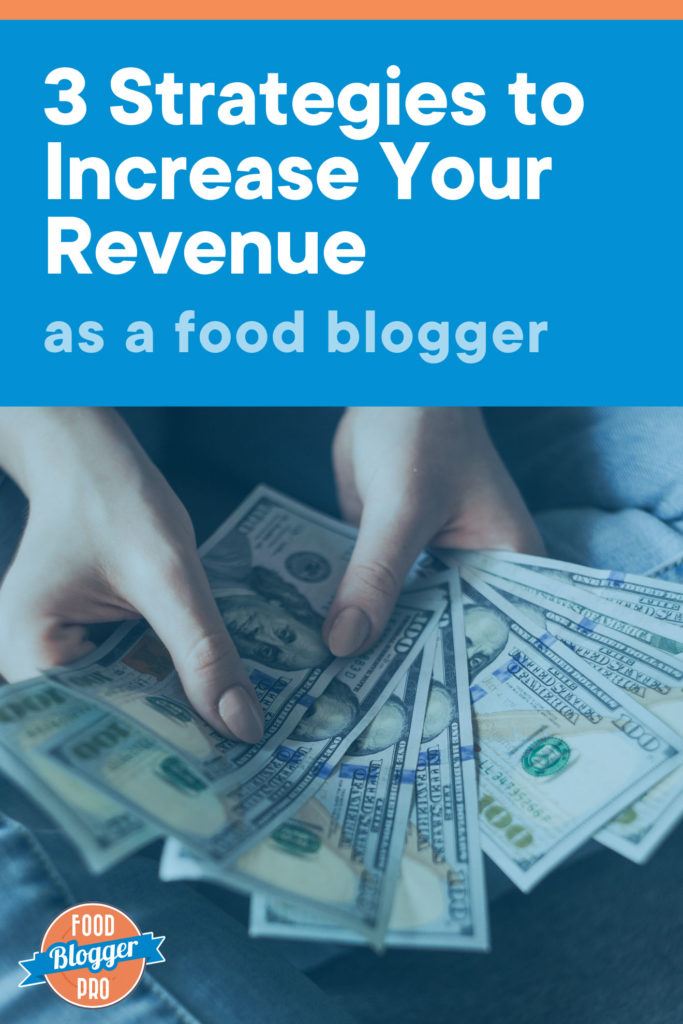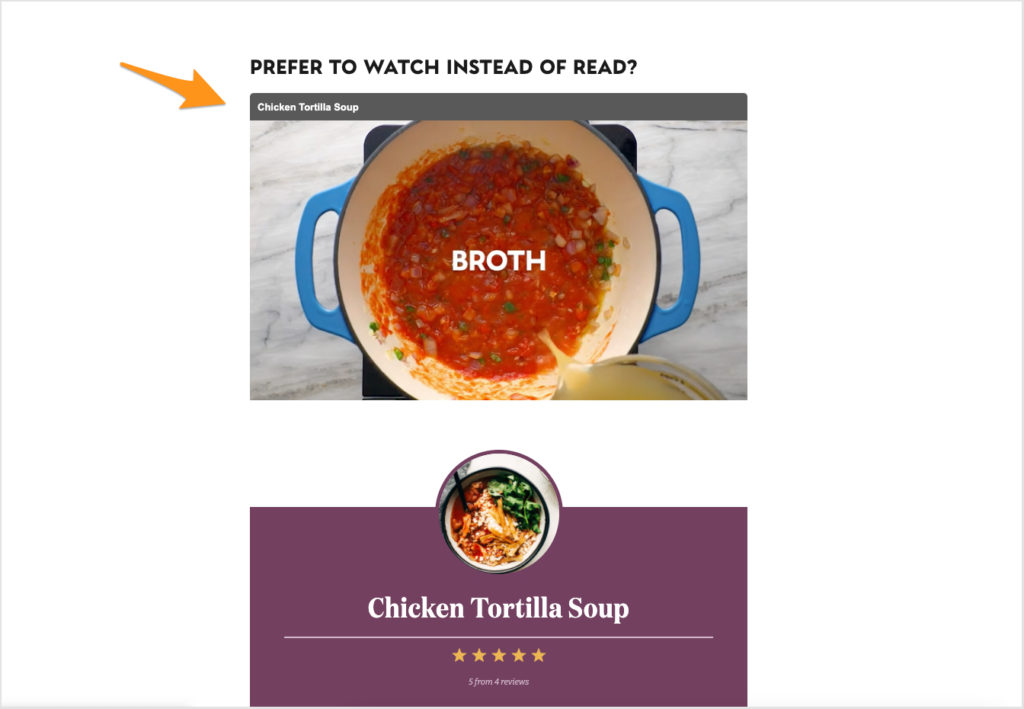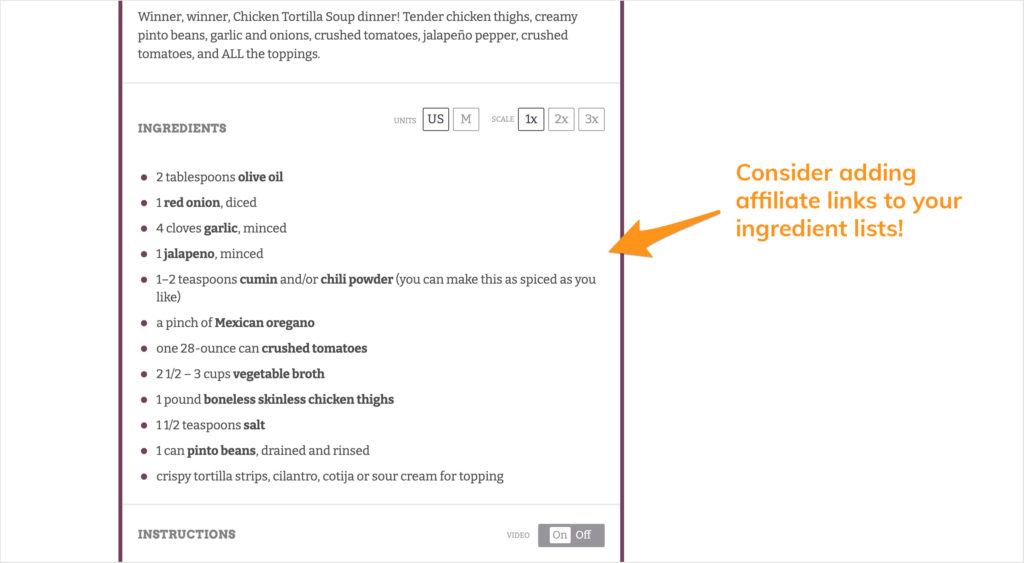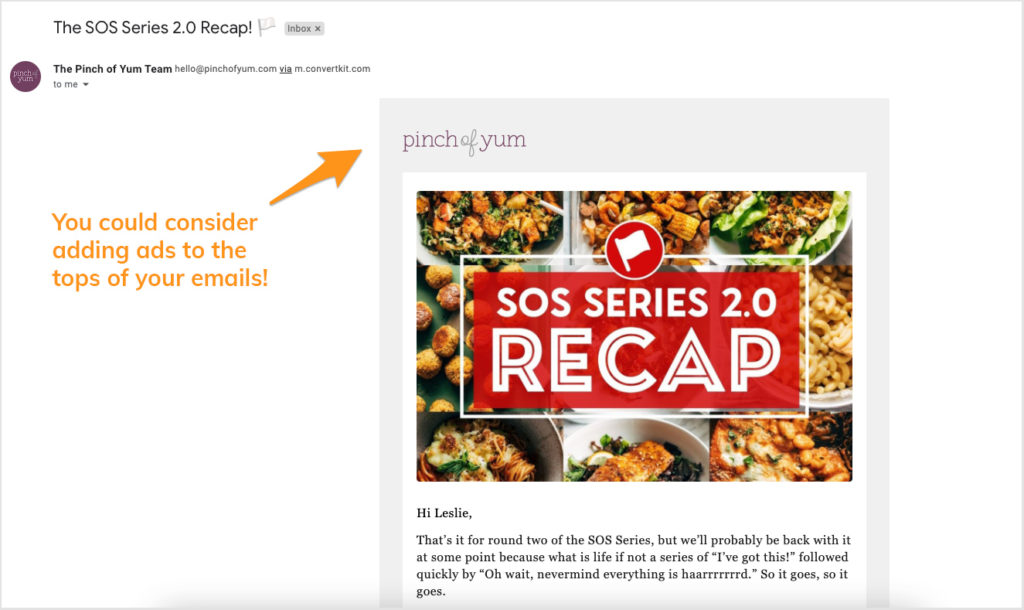
Hi there, folks! Bjork here. 👋
I’m hopping on the Food Blogger Pro blog to share some thoughts around a few updates we made recently over on Pinch of Yum that have helped increase earnings.
As you know, our mission at Food Blogger Pro is to help you get a tiny bit better, every day, forever. My hope is that this blog post does exactly that.
But first, a concept I’d like to share:
Juicing the Orange
Our job as content creators is to, well, create content. Duh, right?
We ask questions like…
- What’s going to resonate with my readers?
- What content gets a lot of likes on Instagram?
- What will rank on Google?
- What might go viral on TikTok?
But if you’re anything like me, you maybe don’t think as much about this question: How is this content best monetized?
Most content creators do a lot of thinking around increasing traffic, likes, and followers. Again, that’s your job: creating content. But most content creators don’t spend much time thinking about optimizing the monetization methods with that content.
Okay, okay… I admit the phrase “optimizing the monetization methods” is incredibly unfun to say (or read), so instead I’d like to propose we use the phrase “juicing the orange.”
We’ve already talked about this before on the blog and on The Food Blogger Pro Podcast, so you might already be familiar with this phrase. If not…
Juicing the orange simply means getting all the juice (i.e. value) out of your orange (i.e. content).
We’ve been trying to get better about thinking about how we can juice the orange on Pinch of Yum, and I’d like to share a few examples with you.
But first, let’s look at another business.
How Baseball Teams Juice the Orange
I know, I know. A sports analogy. Sports sports sports.
I’m not really a “baseball guy,” but some of my friends are, which means that I end up going to a few baseball games each year. I usually end up at a Minnesota Twins or St. Paul Saints game.
I love the mix of people, food, leisure, and… random observations around how other businesses are run. 🙂
One of the things I’ve noticed (and now you will too next time you go to a game, if you haven’t already) is the number of companies and brands and sponsors that are intertwined into the experience.
Here are just a few of the ways a baseball team makes money:
1. Your ticket
2. The name of the stadium
3. A brand sponsoring the bobblehead
4. Parking
5. Food and drinks
6. Merchandise
7. Advertising on jerseys – Not now (for MLB) but probably in the future. This has already happened in the NBA.
8. Sponsoring a certain section or area of the stadium
9. Sponsoring the kiss the cam
10. Sponsoring the seventh-inning stretch
We could go on and on (and on). And all of this is for an experience you’re paying to attend!

How to Get Strategic with Your Monetization Strategy
The point here isn’t that you should SPONSOR ALL THE THINGS when it comes to your blog and your business.
The point is that we, as content creators, should think strategically not just about traffic- and audience-building but also about our strategy around monetization. From a revenue growth perspective, I’d propose that it’s just as valuable to spend time strategizing around how you can increase the revenue per pageview (or follower) as it is to think about increasing pageviews in general.
The good news here is that there’s a 100% chance that any blogger or publisher reading this can juice the orange with their current monetization strategy.
Here are a few examples of how Pinch of Yum has been juicing the orange over the past year or so. The first two are things we’ve done and the last one is something we’re looking into.
1. Switching from YouTube to AdThrive Videos
One major change we’ve been making over the past year is migrating all our YouTube video embeds to AdThrive (now Raptive!) video embeds.
There’s no secret sauce or crazy strategy here — it’s simply removing the YouTube video player on a Pinch of Yum post and replacing it with an AdThrive video player. It’s still the same video, but just a (much) more impactful way to monetize that video content. The strategy here (if you can call it that) was looking at an asset we had (video) and thinking about how we could juice the orange with it.
The impact? Ad earnings increased 30x!
My guess is that there are 2-3 additional wins of this size that are still to be uncovered within Pinch of Yum. I’m not 100% sure where they are right now, but our goal with the ‘juicing the orange’ thinking is to uncover them.

Takeaways:
- If you have YouTube videos on your blog, consider migrating them over to an ad network’s video player.
- If you don’t have videos on your site, consider creating some for your most popular articles or recipes.
- If you don’t have high views or traffic to those pages, but you have a nice audience, perhaps you could update the video to be sponsored by a brand that aligns with the topic of the video.
2. Recurring Revenue via Links
Recently we’ve been beta testing a form of recurring revenue on Pinch of Yum with a brand that is paying to have links to their products within our recipe cards. (To be clear, since these are paid links, they are no-follow links with disclosures.)
The win here for Pinch of Yum is that we’re finding areas within the site that previously wouldn’t have been monetized (i.e. the ingredient list) and monetizing them in ways that don’t feel overly intrusive. In this instance, it’s more helpful for a user to have a link to that specific brand’s version of an ingredient rather than an ad.
Right now, the amount of revenue from this is small (less than $500/month), but we’re still in the beta testing stage. It’s easy to imagine finding 5-10 brands who might be willing to sponsor certain ingredients on the blog (sugar, for instance) and the substantial revenue impact that could have.
This might sound obvious, but the nice thing with recurring payments is that it’s not a one-time payment like a traditional sponsored content deal. The payment is aligned with the value that we’re offering, which is recurring and ongoing.
In this way, it’s almost like we’re looking at the blog as a commercial building and thinking about the “rooms” or areas that we’d want to rent out and trying to find good tenants to rent those rooms. The tenants pay for space as long as they find it valuable, and if the space becomes more valuable over time, then we’d be able to increase the price.

Takeaways:
- What are the ways you can earn recurring revenue from your blog?
- Could you reach out to the current sponsors you work with and see if this is something they’d be interested in?
- Do you have a recurring segment you do on social or on your blog? Would there be a company that might be interested in sponsoring that?
3. Email Newsletters
For most food bloggers, email seems to be an orange that hasn’t been juiced much, if at all.
Part of the reason is that there isn’t a really obvious solution for what to do with it. Most of us don’t have a really specific thing we’re selling, so we end up just using email to point people back to your website, which isn’t bad, but it usually doesn’t have a huge impact on revenue.
We’ve been spending some time with Pinch of Yum thinking about how we can juice the email orange, and one of the things we’re looking into is sponsorships within an email.
The basic idea with this is that a company pays to get its logo (and link) at the top of the email. It’s basically an ad but within an email. Not too complicated! In case you’re interested in seeing how this works, Product Hunt is a company that does this really well.
We haven’t implemented this yet, so we don’t have any specific numbers to report, but it’s just an example of ways that we’re continuing to explore how we can juice the orange. We’re looking into a few options and tools that will help us do this, so if you know of any, let me know!

Takeaways:
- Think about ways to capture the value you create in places other than your blog (like email).
- Tell Bjork if you have any tips for doing sponsorships in email newsletters.
- You could potentially combine #2 (Recurring Revenue via Links) and #3 (Email Newsletters) by including a permanent, sponsored email as a part of your automated emails that go out after someone signs up.
——————–
I know we covered a lot in this post! After reading this, we hope you walk away feeling inspired to get the most out of your existing content and optimize your monetization strategy.
And if you’re looking to dive deeper into the topic of earning income from your blog, we recommend checking out:
- Our monetization-focused episodes of The Food Blogger Pro Podcast,
- The monetization-related articles on the Food Blogger Pro blog, and
- The conversations and courses within the Food Blogger Pro community!
Now we’d love to know: Are you going to implement any of these strategies? How do you earn money from your food blog? Let us know in the comments below!
Bjork, this is a great post! You’ve outlined 3 really smart, creative ways to monetize existing content – love it. One consideration with respect to “Switching from YouTube to AdThrive Videos” is that yes, recipe publishers can and should monetize video with their ad network in this top 1/3rd of their posts (as you’ve suggested). But many can ALSO participate in video SEO in Google search by including a YouTube video (with key moments added) in their recipe card too. The best of both worlds 🙂
This is great, Liane!
AdThrive allows you to markup a video with structured data and also has the option for a video sitemap.
Are there other video SEO-related items you were thinking about that are missed out on when you switch out a YouTube embed?